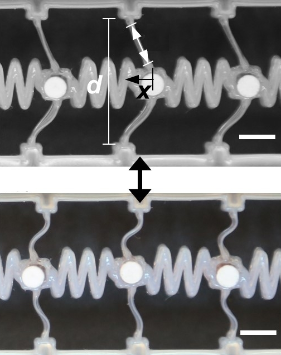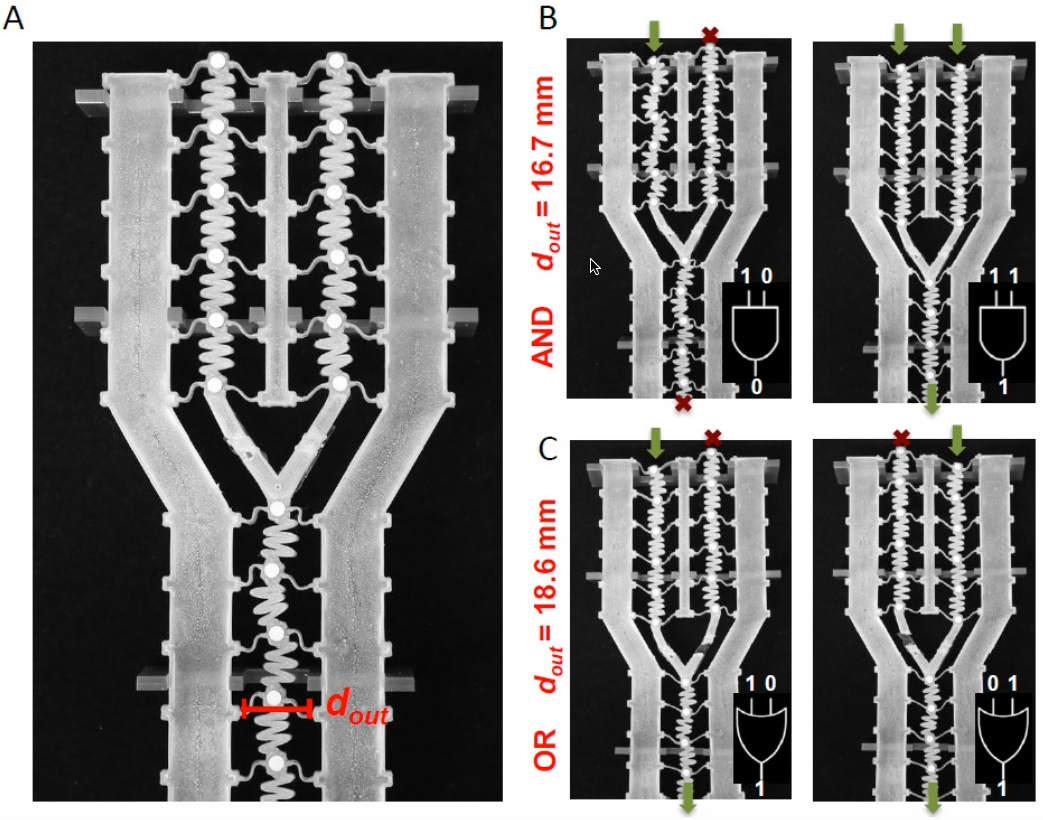Harvard, Caltech design mechanical signaling, diodes, logic gates for soft robots
August 10, 2016

The Harvard/Caltech system for transmitting a mechanical signal consists of a series of bistable elements (the vertical beam, d, shown here) connected by soft coupling elements (wiggly lines), with two stable states. (Top) When a beam is displaced (by amount x), it stores energy. (Bottom) When it snaps back, it releases that stored energy into the coupling element on the right, which continues down the line, like dominos. (Scale bars represent 5 mm.) (credit: Jordan R. Raney/PNAS)
A new way to send mechanical signals through soft robots and other autonomous soft systems has been developed by researchers at the Harvard John A. Paulson School of Engineering and Applied Sciences (SEAS), in collaboration with colleagues at the California Institute of Technology, described in the journal Proceedings of the National Academy of Sciences.
Soft autonomous systems, just like the human body, can perform delicate movements that are safe for humans, unlike mechanical actuators controlled by wires. The problem is that in sending a mechanical signal through a soft material — to make a robot “muscle” move, for example — the signal becomes dissipated (weakened) and dispersed (scattered).
Think tapping on a solid wall to communicate via morse code with someone in the next room vs. tapping out a muffled message on a wall covered with thick, soft foam.
Transmitting signals through soft materials
The researchers solved this problem by using “bistable beams” (structures that function in two distinct states) to store and release elastic energy along the path of a wave.
This new system consists of a chain of bistable elastomeric (rubber-like) beam structures connected by elastomeric linear springs. When a beam is deformed (bent), it snaps and stores energy. As the signal travels along the elastomer, it snaps the beam back into place, releasing the beam’s stored energy and sending the signal downstream, like a line of dominos. This simple bistable system prevents the signal from dissipating downstream.
“This design solves two fundamental problems in transmitting information through materials,” said Katia Bertoldi, the John L. Loeb Associate Professor of the Natural Sciences at SEAS and senior author of the paper. “It not only overcomes dissipation, but it also eliminates dispersive [spreading out] effects, so that the signal propagates without distortion. As such, we maintain signal strength and clarity from start to end.” The team used advanced 3D printing techniques to fabricate the system.
Soft diodes and logic gates

(A) A bifurcated (split into two) signal chain demonstrating tunable logic in a soft mechanical system. The distance d(out) determines the logical behavior, producing either an AND or an OR gate from the same system. (B) When d(out) is small (in this case, 16.7 mm) the energy barrier is higher, so both input signals must be strong to enable the wave to propagate through the output — a logical AND gate; (C) By increasing d(out) (to 18.6 mm in this case), the energy barrier decreases, producing a logical OR gate; in which case, either (or both) input signal has sufficient energy to trigger an output signal. (credit: Jordan R. Raney/PNAS)
The team also took the system a step further, designing and 3D-printing soft diodes and logic gates (a basic computational element that is normally part of a computer chip) using this same signal-transmission design. The gate can be controlled to act either as an AND (both inputs must be present to trigger the gate to fire) or as an OR gate (either one or both will trigger the gate to fire).
This research was supported by the National Science Foundation and the Harvard University Materials Research Science and Engineering Center (MRSEC).
Abstract of Stable propagation of mechanical signals in soft media using stored elastic energy
Soft structures with rationally designed architectures capable of large, nonlinear deformation present opportunities for unprecedented, highly-tunable devices and machines. However, the highly-dissipative nature of soft materials intrinsically limits or prevents certain functions, such as the propagation of mechanical signals. Here, we present an architected soft system comprised of elastomeric bistable beam elements connected by elastomeric linear springs. The dissipative nature of the polymer readily damps linear waves, preventing propagation of any mechanical signal beyond a short distance, as expected. However, the unique architecture of the system enables propagation of stable, nonlinear solitary transition waves with constant, controllable velocity and pulse geometry over arbitrary distances. Since the high damping of the material removes all other linear, small amplitude excitations, the desired pulse propagates with high delity and controllability. This phenomenon can be used to control signals, as demonstrated by the design of soft mechanical diodes and logic gates.